1H NMR-Based metabolomics and 13C isotopic ratio evaluation to differentiate conventional and organic soy sauce
⁎Corresponding authors at: Department of Chemistry, Khwaja Fareed University of Engineering & Information Technology, Rahim Yar Khan 64200, Pakistan (G.M. Kamal). Department of Pharmaceutical Chemistry, College of Pharmacy, King Khalid University, Abha 62529, Saudi Arabia (J. Uddin). mustafa.kamal@kfueit.edu.pk (Ghulam Mustafa Kamal), jalaluddinamin@gmail.com (Jalal Uddin) juddin@kku.edu.sa (Jalal Uddin)
-
Received: ,
Accepted: ,
This article was originally published by Elsevier and was migrated to Scientific Scholar after the change of Publisher.
Abstract
Organic foods gaining popularity due its connection with the health, high nutritional value, and high quality. Therefore, it is of prime importance to develop the analytical methods to combat with food authentication and protect consumer from the food fraud. Conventional soy sauce (CS) and organic soy sauce (OS) were characterized and differentiate for the first time using 1H NMR-based metabolomics approach. Classification methods like orthogonal partial least squares of discriminant analysis (OPLS-DA) showed a significant (p < 0.01) separation among CS and OS yielding important metabolites contributing towards this separation. OS was characterized by increased levels of leucine, threonine, isoleucine, valine, choline, phenylalanine, tyrosine, lactate, and acetate whereas, CS showed elevated concentrations of glutamate, glucose, and sucrose. The abundance ratio of 13C to 12C was determined by 1H NMR spectroscopy which showed an increased ratio of 13C isotope in OS samples indicating the organically grown wheat and soybean used for the preparation of OS. The results can be helpful to convey the information to the end-user to prevent them from economically motivated adulteration. This information could also pave the way to further trace and authenticate the raw materials used in the production of soy.
Keywords
1H NMR spectroscopy
Metabolomics
13C Isotopic ratio
Food authentication
Food adulteration
Soy sauce
1 Introduction
The quality of food is crucial for the health and safety of human beings. Organic foods have become popular in recent years, as consumers are now more health conscious (Dangour et al., 2010), and understand that the organic foods are healthier than conventionally produced foodstuffs (Magnusson et al., 2003, Yiridoe et al., 2005). There is an increase in demand of organic foods throughout the Western World (Ditlevsen et al., 2019). Healthiness has been found to be the main motivation behind increased use of organic foods (Rizzo et al., 2020). Separate food sections devoted to organic fruits and vegetables and foods prepared by organic raw materials have now been arranged by many stores and supermarkets. Uplift in the sales of organic foods in the United States was recorded from approximately $11 billion in 2004 to an estimated $49.4 billion in 2017 (USDoER, 2015). The global organic food market is expected to grow from $201.77 billion in 2020 to $221.37 billion in 2021 (BRC, 2021). Since consumers are always ready to pay more for buying organic products, acclaimed with better quality as compared to conventional food products, the risk of conventional products fraudulently labelled as organic products is a common practice. The prices of organic foods are much higher in China as compared to the conventional foods. The price differences sometime vary as higher as from 20 to 100% (Lin et al., 2008). Proper regulations and standards for organic products have been implemented. A food product to be categorized as organic should follow the instructions of Regulation No. 834/2007 or both the instructions of the regulation and the orders of various farming associations for organic products. Any organic food product should be labelled with an identification number (code) following Regulation No. 834/2007 and the European organic farming logo (both issued after a certification process).
The significant difference between the organic and conventional farming systems is the prohibition of pesticides and synthetic fertilizers. In organic farming mainly the organic fertilizers like animal droppings, compost, or green manures are used. Similarly, biological pest control strategies are adopted instead of synthetic pesticides (Laursen et al., 2013, EC, 2008). These differences in farming practices and nutrient resources are reflected in the chemical composition of agricultural products. Whereas microorganisms carry the fermentation process and as a result, high-value products are yielded from low-quality raw materials. In a more precise way, it can be summarized that microorganisms support the fermentation process resulting in more desirable compounds. In this way, the substrate properties are improved by the synthesis and enhancement of biologically active molecules (Hussain et al., 2016, Parvez et al., 2006). As a result of fermentation, larger nutrient molecules are converted to smaller and easily usable molecules thus improving the nutritional quality of food materials. The yield and quality of the fermentation products are of much importance so the optimization of various parameters like microbial culture medium, temperature, pH, type of solvent and fermenting microorganisms, microbial loading and the fermentation aging period are of vital importance (Hur et al., 2014, Huynh et al., 2014, Lin et al., 2010, Thavasi et al., 2009, Xu et al., 2013). Any alterations in one of these factors can considerably influence the chemical composition and quality of the final products obtained from fermentation. It is therefore expected that the concentrations of metabolites resulting from fermentation process can vary in variety of ways not only depending on the nature of the raw materials.
Soy sauce is a traditional fermented seasoning that originated mainly from East Asian countries, but currently it is being used in cooking worldwide. Flavouring compounds of soy sauce improve the taste of foods while its colouring ingredients enhance the appearance of the dipped food or the mixed soup. In recent studies, it has been proved that some ingredients in soy sauce are potentially beneficial to human health, serving as anticarcinogenic, antineuroinflammatory and antihyperlipidemic (Jayachandran and Xu, 2019, Kim et al., 2016, Zhu et al., 2008). Now a day, like other foods, organic soy sauce manufactured by using organic soybean and wheat as a raw material is abundantly supplied in the market. It is very important to know whether people are buying an improved quality of food or just wasting money for their false mental satisfaction. Therefore, , it is a need of the time to evaluate whether the differences among organic and conventional soy sauce are due to the different raw materials or the products only differ due to the variations in processing conditions.
Extensive research is required to test and authenticate organic food products in order to facilitate the consumer’s choice (Siderer et al., 2005), because it is very easy to mislead the consumers by mislabelling the conventional food products as “organic”. Numerous reports are available in the literature studying the variation in a number of quality factors of grains, such as wheat and soybeans grown in conventional and organic farms (Arncken et al., 2012, Balisteiro et al., 2013, Mäder et al., 2007, Mazzoncini et al., 2015, Nitika et al., 2008, Vinković Vrček et al., 2014). However, up to our knowledge, there are no reports available in the literature comparing the compositional features of fermented foods, especially soy sauce produced by raw grain materials (soybean and wheat) coming from conventional or organic farming systems, that may be because the composition of foods produced specially through fermentation processes is very complex in spite of the raw materials. However, it can be hypothesized that different raw materials in fermented food may lead to differences in the content and the isotopic ratios (13C, 15N and 2H) of some components. Therefore, quantifying the relative content and isotopic ratios can be used to authenticate the organic fermentation foodstuffs.
1H NMR spectroscopy is one of the broadest, simple, and non-destructive multinuclear techniques which can provide real time screening of a variety of compounds present in any given sample (Figueiredo et al., 2006). Application of 1H NMR-based metabolomic is well documented in food analysis (Kamal et al., 2021). There are few studies published on NMR-based metabolomics approach in combination of different analytical techniques, demonstrated the capability to differentiate organically and conventionally grown foodstuffs, like honey (Consonni et al., 2019), coffee (Consonni et al., 2018), milk (Tsiafoulis et al., 2019, Erich et al., 2015), tomatoes (Hohmann et al., 2015), Brassica oleracea (Lucarini et al., 2020) and potatoes (Pacifico et al., 2013). In the present study, a recently published method (Wang et al., 2020a) was applied with an aim to reveal the compositional variations among conventional and organic soy sauce. Similarly, the abundance ratio of 13C isotope was also determined by 1H NMR spectroscopy to trace and authenticate the organic raw materials used to produce organic soy sauce.
2 Experimental
2.1 Collection and preparation of samples
In total, 13 samples (Organic super light = 8; Conventional super light = 5) of soy sauce were procured from local commercial market, as well as from Jicheng Soy Sauce Brewing Company based in Suzhou China. Sample preparation for 1H NMR spectroscopic analysis was accomplished by dissolving 60 µL sample in 480 µL buffer (0.05 M) and 60 µL 2.5 mM Trimethylsilylpropanoic acid (TSP) prepared in 100% deuterium oxide. Sample mixtures pD was recorded and maintained at 5.0 ± 0.05 by phosphate buffer (0.05 M). Samples were centrifuged for 10 min, and the supernatants were shifted to NMR sample tubes.
2.2 Chemicals
Analytical grade chemical and reagents were used. D2O (99.9%), sodium salt of TSP (99.9 atom %), Na2HPO4, NaH2PO4 were procured from Sigma (St. Louis, MO).
2.3 1H NMR analysis
All NMR spectra were recorded on Bruker Avance 600 MHz NMR spectrometer (Bruker Biospin GmbH, Germany) working at 1H frequency of 600.1699 MHz and a temperature of 298 K by a TXI Probe. While acquiring the 1H NMR spectra, solvent (H2O) signals were suppressed by using pre-saturated 1D NOESY method and the parameters for observing the results were as follows: data points collected, 32 K; spectral width; 9000 Hz; acquisition time, 1.8 sec.; relaxation delay time, 1sec; number of scans acquired, 128. Chemical shifts were standardized after referencing with chemical shift of TSP (1H, δ 0.00 ppm). Each spectrum was apodized using the exponential window function with the line width factor of 0.3 Hz before Fourier transforming (FT). Signal assignment was accomplished by 1D 13C NMR spectroscopy, 2D 1H–1H total correlation spectroscopy (TOCSY), 2D hetero-nuclear single quantum correlation spectroscopy (HSQC) for some selected representative samples and spectral databases available publically.
2.4 NMR spectroscopy for 13C isotopic ratio evaluation
To evaluate the natural abundance ratio of 13C isotope hypothesized to be expressed in organic soy sauce (OS) from organic soybean and wheat, a modified water pre-saturated NOESY 1D spectroscopy was conducted, in which the effect of 13C isotropic ratio has been modulated by turning on and off the carbon decoupling (Wang et al., 2020b). Two different 13C frequency offset values were set in an interleave mode to avoid the carbon resonance bias. The 13C decoupling-on spectra were performed with the 13C offset at 60 ppm, and the other ones with 13C decoupling-off were performed with the 13C offset at 300 pm. For both spectra, 8 K data points were collected by using 1 K scans acquired with the spectral width of 9014 Hz (∼15 ppm) and the acquisition time of 0.454 s. The d1 relaxation time was set to be 5 s. Consequently, the total repetition time becomes 5.454 s.
2.5 NMR data analysis
Peak shift in 1H NMR spectra is one of the most exasperating factors considering in perspective of the multivariate analysis of spectral data (Ebbels et al., 2011). Instrumental, pH, temperature and salt concentration differences, overall dilution factors and relative concentration of specific ions are among the most vital reasons causing this shift. The effect of these factors is normally not the same for all peaks. The revelation of useful information in the spectra is sometimes not clear because of these issue (Defernez and Colquhoun, 2003, Vogels et al., 1996, Witjes et al., 2000). To overcome the phase and alignment issues, spectra were tried by manual phasing at first and then baseline correction was performed in Topspin software 3.2 (Bruker Biospin, GmbH, Germany). After that the spectral data were imported into MATLAB (R2012B, Mathworks Inc. 2012) and an in-house developed algorithm namely NMRSpec was applied to re-align the spectra in MATLAB (Yue et al., 2015). This tool is a free for researchers to use and has already been applied to NMR data successfully (Kamal et al., 2016). Data representing all samples were divided into 0.004 ppm spectral buckets and integrated. The regions having no significant signals and solvent region from 4.70 − 5.2 ppm were excluded prior to the spectral alignment. Following the alignment and bucketing, the spectral data were then normalized with respect to total spectral area to compensate for the total concentration variations.
The isotopic ratio change of 13C has been evaluated by comparing the change of the normal 1D 1H NMR spectroscopy without or with 13C decoupling following an already developed method (Wang et al., 2020a). For molecules at natural abundance, in normal 1H NMR spectra usually without 13C decoupling, signals from 1H atoms bonded to 13C atoms
2.6 Multivariate data analysis
Multivariate analysis was conducted on the normalized and bucketed NMR data sets using software package SIMCA version 14 (Sartorius Stedim Biotech). The resulting spectral data after bucketing and normalization were analysed by SIMCA 14 (Umetrics, Umea, Sweden). The pareto scaling was used for all multivariate analyses. PCA was used first to unveil the internal variation in the dataset and to detect any outliers if present. PCA scatter plot showed an obvious separation of OS from CS indicating unique features. Partial least squares-discriminant analysis (PLS-DA) and orthogonal partial least squares-discriminant (OPLSDA) models were then calculated to further clarify the separation finding variables accountable for differentiation among OS and CS. The total variance of the components at a confidence level of 95% defines the quality of the model. R2X and Q2 represented the goodness of fit and overall predictive ability of the model. Models were authenticated applying CV ANOVA at p < 0.05. Compounds showing significant variations were explored from OPLSDA correlation coefficient colour coded loading plots. The extracted variables were then plotted in standard error bar graphs using their normalized relative intensities and explained as unique features for the respective soy sauce types.
3 Results and discussion
3.1 1H NMR spectroscopy
OS and CS were compared with each other in order to know whether the differences are due to conventional and organic raw material or the different ways of manufacturing. Fig. 1 shows the selected 1D 1H NMR spectra of OS and CS. In total 22 signals were assigned in 1H NMR spectra (Fig. 1). Apparently, the profiles of the spectra are nearly the same, the main differences are the relative signal intensities, such as the signals around 2.0 ppm, whose intensities are much smaller in the organic soy sauce than that in the conventional one, whereas the signals of the organic soy sauce in the downfield are relatively higher than that of the conventional one.
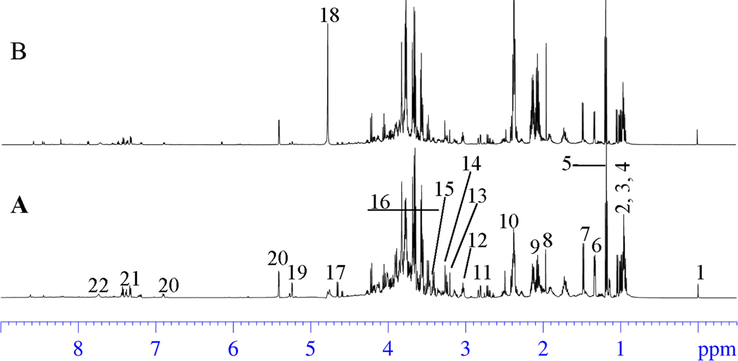
- Representative 1H NMR spectra from organic super light (A) and conventional super light (B) soy sauce samples. Peaks: 1, TSP; 2, Isoleucine; 3, Leucine; 4, Valine; 5, Threonine; 6, Alanine; 7, Lactate; 8, Acetate; 9, Glutamate; 10, Methionine; 11, Aspartate; 12, γ-amino butyric acid; 13, Choline; 14, Glucose; 15, ß-glucose; 16, Glucose & aliphatic region; 17, ß-glucose; 18, Solvent (H2O); 19, α-glucose; 20, Fumarate; 21, Tyrosine; 22, Phenylalanine; 23, Formate.
The identification of the metabolites was performed using our in-house database as well as freely available online databases like HMDB, MRB, SDBS etc. Furthermore, 2-dimensional NMR experiments like HSQC, TOCSY and HMBC were also performed for representative samples to facilitate the signal assignments (Table 1).
| Sr. No. | Compound | 1H NMR chemical shift | Multiplicity |
|---|---|---|---|
| 1 | TSP | 0.00 | Singlet |
| 2 | Isoleucine | 0.93 | Triplet |
| 3 | Leucine | 0.97 | Doublet |
| 4 | Valine | 0.98 | Doublet |
| 5 | Threonine | 1.33 | Multiplet |
| 6 | Alanine | 1.35 | Doublet |
| 7 | Lactate | 1.42 | Doublet |
| 8 | Acetate/acetic acid | 1.95 | Singlet |
| 9 | Glutamate | 2.10 | Multiplet |
| 10 | Methionine | 2.50 | Triplet |
| 11 | Aspartate | 2.75 | ABX |
| 12 | γ-amino butyric acid | 3.01 | Multiplet |
| 13 | Choline | 3.20 | Singlet |
| 14 | Glucose | 3.23 | Triplet |
| 15 | β-Glucose | 3.40 | Triplet |
| 16 | Glucose, aliphatic region | 3.50–4.25 | ------- |
| 17 | β-Glucose | 4.65 | Doublet |
| 18 | Solvent (H2O) | 4.78 | Singlet |
| 19 | α-Glucose | 5.21 | Doublet |
| 20 | Fumarate | 6.85 | Singlet |
| 21 | Tyrosine | 7.30 | Doublet |
| 22 | Phenylalanine | 7.42 | Multiplet |
| 23 | Formate | 7.75 | Formate |
*The chemical shifts were determined at pD 5 ± 0.05 and expressed as relative values to those of TSP at 0 ppm.
3.2 Multivariate statistical analysis
For exploring difference among OS and CS, a total of 13 soy sauce samples were studied by 1H NMR spectroscopy combined with PCA analysis. PCA classifies samples in data set according to their similarities requiring no prior information about the dataset and reducing the dimensions of data and keeps most of the variation within data (Choi et al., 2004). Score scatter plot of OS and CS samples resulted with R2X (64%) and Q2 (44%) (Fig. 2). The scatter plot (Fig. 2) is obtained as PCA outcome from 1H NMR spectra of OS and CS. R2X shows the goodness of fit and Q2 shows the predictive ability of the PCA model (Jung et al., 2010). The PCA illustrates an apparent separation among soy sauce samples prepared using organic and conventional raw materials indicating that there are unique metabolic characteristics of OS and CS samples.
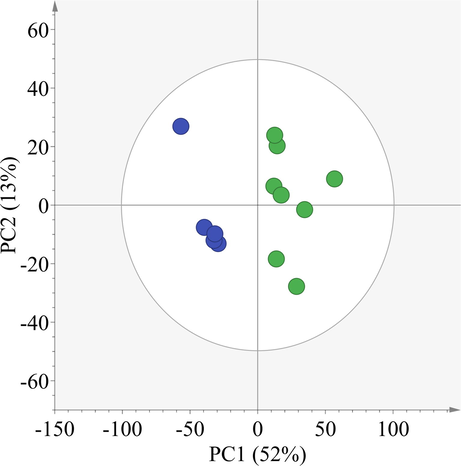
- PCA score scatter plot showing complete separation among organic super light (Green circles) and conventional super light soy sauce samples (Blue circles).
In order to understand the metabolic profiles of the two types of soy sauce, PLS-DA and OPLS-DA models were evaluated to further clarify the differences. PLS-DA score scatter plot (Fig. 3A) exhibited complete separation among the OS and CS with R2X; 36%, R2Y; 74% and Q2 of 59%. The score scatter plot of OPLS-DA analysis (Fig. 4A) shows a clear separation of two groups of samples with model parameter R2X; 38%, R2Y; 74% and Q2 of 59%. Fig. 4B is the respective loading line plot that represents the metabolites responsible for differentiation among OS and CS. The metabolites responsible for discrimination are colour coded according to their correlation coefficient. OS were characterized with increased levels of leucine, threonine, isoleucine, valine, choline, phenylalanine, tyrosine, lactate, and acetate whereas, CS samples showed elevated concentrations of glutamate, glucose, and sucrose.
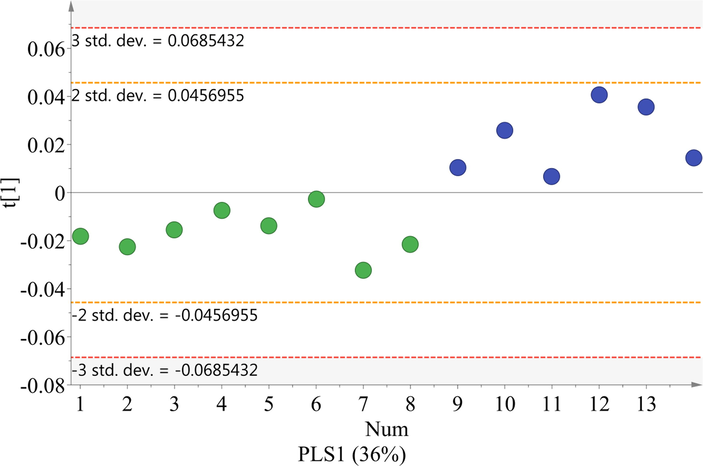
- PLS-DA score scatter plot showing further clarified separation among organic super light and conventional super light soy sauce samples.
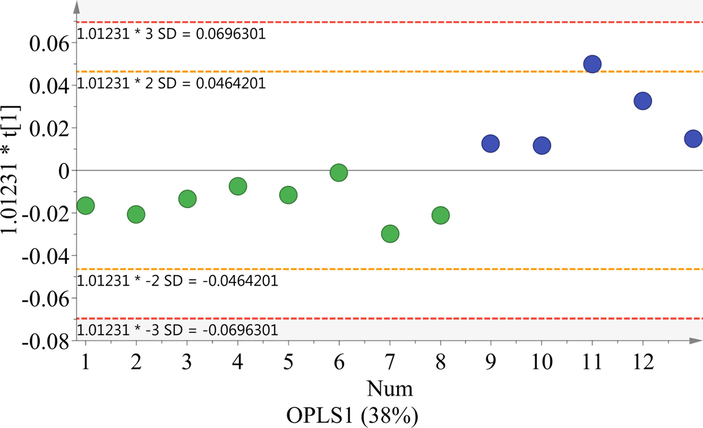
- OPLS-DA score scatter showing discrimination among organic and conventional super light soy sauce.
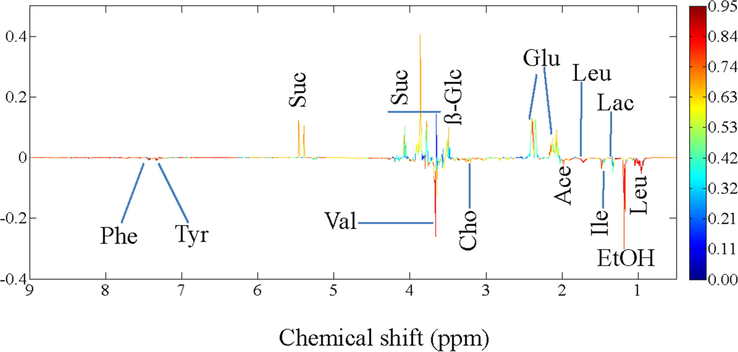
- Loading line plot showing the variables responsible for separation among the two soy sauce types. Colour intensity from blue to red shows the intensity of variation of metabolites among the two soy sauce types.
The metabolites showing the maximum variation were selected with the help of OPLS-DA loading line plots. The average normalized relative intensities of the selected variables were plotted using standard error (SE) bar graphs (Fig. 5) to exploit the variations among the OS and CS samples. A Student’s t-test was also conducted to check the significance of the variations among metabolites. Amino acids like leucine, threonine, isoleucine, valine, choline, phenylalanine and tyrosine and acetate were observed significantly increased concentrations in OS in comparison to the CS samples, as depicted in Fig. 5. Glutamate, glucose, and sucrose were found to be significantly higher in CS samples, when compared to OS samples.
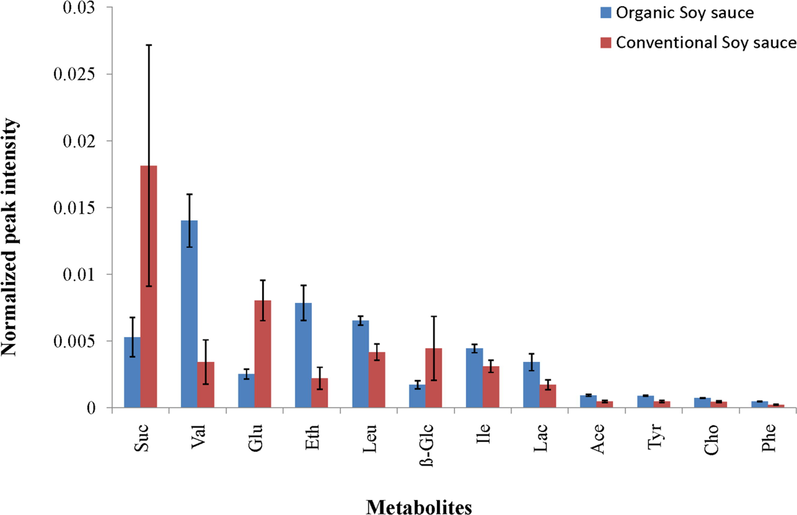
- Concentrations of the metabolites responsible for separation among organic and conventional soy sauce types expressed in terms of their normalized peak intensity.
Amino acids are generally produced from raw materials like soybean and wheat by proteolysis during the meju formation and the sauce fermentation. Initially the microorganisms utilize amino acids as the nitrogenous source for their growth. Later on, some of the amino acids are also produced (Ko et al., 2009), because the soy or wheat proteins would be degraded to amino acids by enzymes during the fermentation. In the present study, the higher amounts of amino acids suggest the prolonged aging period for the fermentation of organic soy sauce in comparison to the conventional soy sauce. That seems to be reasonable because the organic crops usually need more time to mature without fertilizer, therefore raw materials from organic crops may be difficult to be fermented. Nevertheless, this result illustrates that the OS with prolonged aged fermentation deserves more attention from the consumers as compared to the conventional soy sauce.
As a unique amino acid, tyrosine is often converted to tyramine through microbial decarboxylation during fermentation of foods and vegetables (Silla Santos, 1996). Many factors like microfloral type, raw materials, pH and salt content are involved in the decarboxylation of tyrosine into tyramine (Nout et al., 1993). Therefore, increased tyrosine levels in OS as compared to CS shows that different procedures for fermentation were adopted to produce organic and conventional soy sauce.
Choline is very important nutrient present in foods. Its deficiency can cause steatosis and damage to human liver (Zeisel et al., 1991), retardation in growth, renal dysfunctions, and haemorrhage or abnormalities of bones in animals (Handler and Bernheim, 1949, Newberne and Rogers, 1986). Significantly increased levels of choline present in OS compared to the CS samples suggested that the OS may be healthier than CS. Further nutrition intake-based biomarker (Nutri-metabolomic) study should be carried out to examine the effect of OS and CS on endogenous metabolites in human or animals.
Ethanol along with glycerol is produced in soy sauce fermentation by the activity of Zygosaccharomyces rouxii (Radler and Schütz, 1982). Wheat or soybean starch mainly acts as a raw material for synthesis of ethanol and glycerol by the activity of Zygosaccharomyces rouxii. Wheat and soybean contain different amounts of starch in them. Moreover, temperature and duration of fermentation can also cause different degrees of evaporation of ethanol from the fermentation mixture. Significantly higher level of ethanol present in OS than CS, indicates that different raw materials or temperatures were used during the fermentation of organic and conventional soy sauce. However, edible form of ethanol is usually added to soy sauce as a preservative. The significant differences in concentration of ethanol indicate the possible external addition of edible ethanol to the refined OS product.
The levels of acetate and lactate were found significantly higher in OS as compared to CS samples. Acetate is normally synthesized along with formate by lactic acid bacteria (LAB) and inhibits the growth of halophilic yeast which was also observed during the fermentation of Japanese Shoyu and Shigella (Hentges, 1967, Radler and Brohl, 1984). Lactate is also an important organic acid generated through fermentation by the action of LAB and is responsible for imparting a peculiar taste and flavour to the soy sauce.
Glutamate was found in significantly higher levels in CS in comparison to OS samples. It is a significant amino acid present both in raw and fermented types of soy sauce (Luh, 1995) and acts as a key intermediate in LAB metabolism. During fermentation it is used up by aminotransferases and donates amino groups. Glutamate dehydrogenase also synthesizes glutamate during fermentation, from 2-oxoglutarate, in Tricarboxylic acid (TCA) cycle. Glutamic acid and glutamate enhance flavour and umami (savoury) taste. It naturally occurs in a variety of fermentation products including soy sauce, fermented beans, and cheeses etc. Organic salts such as monosodium glutamate (MSG) are extensively used as additives in soy sauce and are responsible for imparting a characteristic umami taste. However, MSG is toxic additive when present in concentrations exceeding the allowed limits. It has been shown by in vitro studies that glutamate is potentialy a neurotoxin if present in concentrations higher than admissible. In such cases, it can cause damage to neurons through apoptosis (Zhang and Bhavnani, 2006). Thus, it is very important to confirm whether the wheat (MSG, glutamine rich) or soybean was used as a raw material in fermentation.
Both α and ß glucose were found in significantly lower levels in OS in comparison to the CS samples. This suggests the prolonged and precise fermentation procedures followed for the fermentation producing organic soy sauce, because the glucose is the energy source for the microorganisms active during fermentation. The increased consumption of oligosaccharides by wine yeast with aging time has been observed in grape wine alcoholic fermentation (Son et al., 2009).
Significantly higher concentrations of sucrose were found in CS in comparison to the OS samples. Sucrose often comes from the manual addition of caramel and its widely used as an additive in soy sauce industry in China. Caramel is normally manufactured by heating a combination of maltose, lactose, and sucrose. During heating lactose splits into monomers while sucrose and maltose remain in abundance (Golon and Kuhnert, 2012, Kuhnert et al., 2010). Along with the sucrose produced during fermentation, the caramel in CS caused a significantly increased concentration of sucrose in CS. This was also verified by listed ingredients on the labels of CS samples.
3.3 13C isotopic ratio
The organic and conventional crops (Soybean and wheat) contain different ratios of 13C isotopes. The differences in 13C isotopic ratio arise from varying impacts of water stress on opening of stomata and simultaneous effect on carbon dioxide flow and fractionation in different agricultural regimes and environments.
Keeping in view the claim of the use of organic wheat, sugar, and soybean in production of organic soy sauce, it is not enough to conclude the results solely based on the fermentation related metabolic changes. Besides, it also needs to authenticate and trace the origin of raw materials to draw a conclusion whether the changes are only because of the different processing methods or otherwise because of the different raw materials. Ratios of 13C isotopic abundance in organic and conventional soy sauce samples have been shown in Fig. 6. The 13C ratio for most of the varying metabolites except glutamate, sucrose and glucose was found higher in organic soy sauce samples when compared to the conventional soy sauce (Fig. 6). This suggests that organic soybean and wheat were used as raw materials to produce organic soy sauce. It also confirmed the extraordinarily increased concentrations of glucose, sucrose and glutamate in the conventional soy sauce coming from the addition of caramel and MSG from external sources.
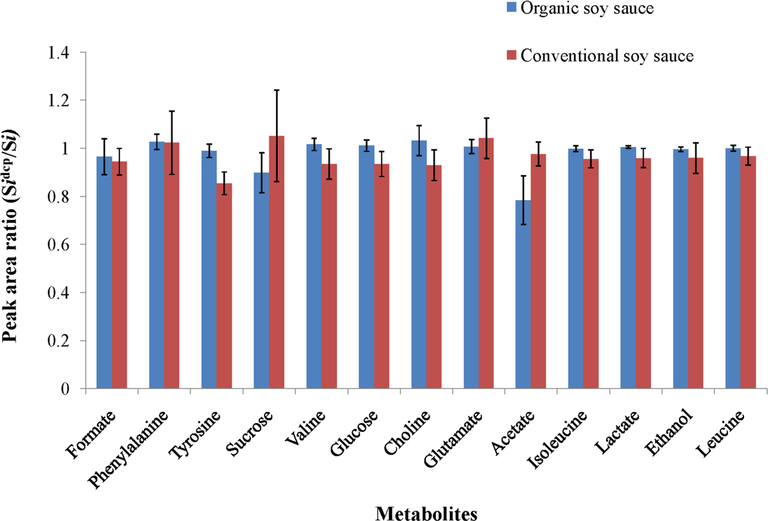
-
13C isotopic ratios profiling in terms of peak areas from decoupling and non-decoupling signals of significantly varying metabolites.
4 Conclusion
In conclusion, current study shows the capability of NMR-based metabolomics approach in characterization and differentiation of organic and conventional soy sauce. The OPLSDA significantly (p < 0.01) separates organic and conventional soy sauce and provides a rapid tool to extract the metabolites responsible for the variation. Fast and simple 1H NMR based method to determine 13C isotopic ratios also facilitates the authentication of organic soy sauce. Finally, it was also confirmed the manual addition of caramel and glutamate in conventional soy sauce. The achieved results, even if preliminary due to the limited numbers of samples, and confined to the investigation of Chinese soy sauce, open the possibility to expand the study at international level, with adequate sampling. The results can be helpful to convey the information to the end user to prevent them from economically motivated adulteration. This information could also pave the way to further trace and authenticate the raw materials used in production of soy.
Acknowledgment
The authors extend their appreciation to the Deanship of Scientific Research at King Khalid University for funding this work through research groups program under Grant No. RGP.1/259/42.
Compliance with Ethical Standards
NA.
Compliance with ethics requirements
All applicable international, national, and institutional guidelines for the ethical requirements were followed by the authors.
Declaration of Competing Interest
The authors declare that they have no known competing financial interests or personal relationships that could have appeared to influence the work reported in this paper.
References
- (Ec), C. R. 2008. Commission Regulation (EC) No 889/2008 of 5 September 2008 laying down detailed rules for the implementation of Council Regulation (EC) No 834/2007 on organic production and labelling of organic products with regard to organic production, labelling and control. Official Journal of the European Union, 008, 173-256.
- Sensory, yield and quality differences between organically and conventionally grown winter wheat. J. Sci. Food Agric.. 2012;92:2819-2825.
- [Google Scholar]
- Protein, isoflavones, trypsin inhibitory and in vitro antioxidant capacities: Comparison among conventionally and organically grown soybeans. Food Res. Int.. 2013;51:8-14.
- [Google Scholar]
- Massimo Lucarini, Maria Enrica Di Cocco, Valeria Raguso, Flavia Milanetti, Alessandra Durazzo, Ginevra Lombardi-Boccia, Antonello Santini, Maurizio Delfini, Fabio Sciubba. 2020. NMR-Based Metabolomic Comparison of Brassica oleracea (Var. italica): Organic and Conventional Farming. Foods, 9(7): 945. doi: 10.3390/foods9070945.
- Metabolic fingerprinting of wild type and transgenic tobacco plants by 1H NMR and multivariate analysis technique. Phytochemistry. 2004;65:857-864.
- [Google Scholar]
- NMR-based metabolomic approach to differentiate organic and conventional Italian honey. Food Control. 2019;98:133-140.
- [Google Scholar]
- Organic and conventional coffee differentiation by NMR spectroscopy. Food Control. 2018;94:284-288.
- [Google Scholar]
- Nutrition-related health effects of organic foods: a systematic review. Am. J. Clin. Nutr.. 2010;92:203-210.
- [Google Scholar]
- Factors affecting the robustness of metabolite fingerprinting using 1H NMR spectra. Phytochemistry. 2003;62:1009-1017.
- [Google Scholar]
- Healthy food is nutritious, but organic food is healthy because it is pure: The negotiation of healthy food choices by Danish consumers of organic food. Food Quality & Preference. 2019;71:46-53.
- [Google Scholar]
- Processing and modeling of nuclear magnetic resonance (NMR) metabolic profiles. Methods in Molecular Biology (Clifton. N.J.). 2011;708:365-388.
- [Google Scholar]
- Combined chemometric analysis of 1H NMR, 13C NMR and stable isotope data to differentiate organic and conventional milk. Food Chem.. 2015;188:1-7.
- [Google Scholar]
- 1H NMR, a rapid method to monitor organic acids during cupuassu (theobroma grandiflorum spreng) processing. J. Agric. Food. Chem.. 2006;54:4102-4106.
- [Google Scholar]
- Unraveling the chemical composition of caramel. J. Agric. Food Chem.. 2012;60:3266-3274.
- [Google Scholar]
- Influence of pH on the inhibitory activity of formic and acetic acids for Shigella. J Bacteriol. 1967;93:2029-2030.
- [Google Scholar]
- Differentiation of organically and conventionally grown tomatoes by chemometric analysis of combined data from proton nuclear magnetic resonance and mid-infrared spectroscopy and stable isotope analysis. J. Agric. Food. Chem.. 2015;63:9666-9675.
- [Google Scholar]
- Effect of fermentation on the antioxidant activity in plant-based foods. Food Chem.. 2014;160:346-356.
- [Google Scholar]
- Fermentation, a feasible strategy for enhancing bioactivity of herbal medicines. Food Res. Int.. 2016;81:1-16.
- [Google Scholar]
- Improved release and metabolism of flavonoids by steered fermentation processes: a review. Int. J. Mol. Sci.. 2014;15:19369-19388.
- [Google Scholar]
- Discrimination of the geographical origin of beef by 1H NMR-based Metabolomics. J. Agric. Food. Chem.. 2010;58:10458-10466.
- [Google Scholar]
- Compositional differences among Chinese soy sauce types studied by 13C NMR spectroscopy coupled with multivariate statistical analysis. Talanta. 2016;158:89-99.
- [Google Scholar]
- An insight into the health benefits of fermented soy products. Food Chem.. 2019;271:362-371.
- [Google Scholar]
- Kamal, G.M., Uddin, J., Tahir, M.S., Khalid, M., Ahmad, S., Hussain, A.I., 2021. Nuclear Magnetic Resonance Spectroscopy in Food Analysis, in: Techniques to Measure Food Safety and Quality. Springer, pp. 137–168.
- Anti-neuroinflammatory activities of indole alkaloids from kanjang (Korean fermented soy source) in lipopolysaccharide-induced BV2 microglial cells. Food Chem.. 2016;213:69-75.
- [Google Scholar]
- Metabolomic Insight into Soy Sauce through 1H NMR Spectroscopy. J. Agric. Food. Chem.. 2009;57:6862-6870.
- [Google Scholar]
- Mass spectrometric characterization of black tea thearubigins leading to an oxidative cascade hypothesis for thearubigin formation. Rapid Commun Mass Spectrom. 2010;24:3387-3404.
- [Google Scholar]
- Is it really organic? – Multi-isotopic analysis as a tool to discriminate between organic and conventional plants. Food Chem.. 2013;141:2812-2820.
- [Google Scholar]
- Organic premiums of US fresh produce. Renewable Agric. Food Syst.. 2008;23:208-216.
- [Google Scholar]
- Antihepatocarcinoma activity of lactic acid bacteria fermented panax notoginseng. J. Agric. Food. Chem.. 2010;58:8528-8534.
- [Google Scholar]
- Liu Yue, Gao Yun-Ling, Cheng Ji, Wang Jie, Xu Fu-Qiang 2015. A processing method for spectrum alignment and peak extraction for NMR spectra. Chinese Journal of Magnetic Resonance, 32, 382-392.
- Wheat quality in organic and conventional farming: Results of a 21 year field experiment. J. Sci. Food Agric.. 2007;87:1826-1835.
- [Google Scholar]
- Choice of organic foods is related to perceived consequences for human health and to environmentally friendly behaviour. Appetite. 2003;40:109-117.
- [Google Scholar]
- Organically vs conventionally grown winter wheat: effects on grain yield, technological quality, and on phenolic composition and antioxidant properties of bran and refined flour. Food Chem.. 2015;175:445-451.
- [Google Scholar]
- Labile methyl groups and the promotion of cancer. Annu. Rev. Nutr.. 1986;6:407-432.
- [Google Scholar]
- Nitika, Punia, D. & Khetarpaul, N. 2008. Physico-chemical characteristics, nutrient composition and consumer acceptability of wheat varieties grown under organic and inorganic farming conditions. International Journal of Food Sciences and Nutrition, 59, 224-245.
- Effect of processing conditions on the formation of biogenic amines and ethyl carbamate in soybean tempe. J. Food Saf.. 1993;13:293-303.
- [Google Scholar]
- NMR-based metabolomics for organic farming traceability of early potatoes. J. Agric. Food. Chem.. 2013;61:11201-11211.
- [Google Scholar]
- Probiotics and their fermented food products are beneficial for health. J. Appl. Microbiol.. 2006;100:1171-1185.
- [Google Scholar]
- The metabolism of several carboxylic acids by lactic acid bacteria. Zeitschrift fur Lebensmittel-Untersuchung und -Forschung. 1984;179:228-231.
- [Google Scholar]
- Glycerol Production of Various Strains of Saccharomyces. American Journal of Enology and Viticulture. 1982;33:36-40.
- [Google Scholar]
- Organic Food Consumption: The Relevance of the Health Attribute. Sustainability. 2020;12:595.
- [CrossRef] [Google Scholar]
- Need for research to support consumer confidence in the growing organic food market. Trends Food Sci. Technol.. 2005;16:332-343.
- [Google Scholar]
- Biogenic amines: their importance in foods. Int. J. Food Microbiol.. 1996;29:213-231.
- [Google Scholar]
- Metabolomic characterization of malolactic fermentation and fermentative behaviors of wine yeasts in grape wine. J. Agric. Food. Chem.. 2009;57:4801-4809.
- [Google Scholar]
- Temperature and solvent effects on radical scavenging ability of phenols. The Journal of Physical Chemistry A. 2009;113:3068-3077.
- [Google Scholar]
- The Business Research Company India. March, 2021. Organic Food Global Market Report 2021. https://www.thebusinessresearchcompany.com/report/organic-food-global-market-report. Accessed on 17-10-2021
- NMR-Based Μetabolomics of the Lipid Fraction of Organic and Conventional Bovine Milk. Molecules. 2019;24:1067.
- [Google Scholar]
- Usdoer 2015. Consumer demand drives growth in the organic food sector.
- A comparison of the nutritional value and food safety of organically and conventionally produced wheat flours. Food Chem.. 2014;143:522-529.
- [Google Scholar]
- Partial linear fit: A new NMR spectroscopy preprocessing tool for pattern recognition applications. Journal of Chemometrics. 1996;10:425-438.
- [Google Scholar]
- An untargeted 13C isotopic evaluation approach for the discrimination of fermented food matrices at natural abundance: Application to vinegar. Talanta. 2020;210:120679
- [Google Scholar]
- Witjes, H., Melssen, W. J., In 'T Zandt, H. J., Van Der Graaf, M., Heerschap, A. & Buydens, L. M. 2000. Automatic correction for phase shifts, frequency shifts, and lineshape distortions across a series of single resonance lines in large spectral data sets. Journal of Magnetic Resonance, 144, 35-44.
- Monitoring of the bacterial and fungal biodiversity and dynamics during Massa Medicata Fermentata fermentation. Appiedl Microbiology and Biotechnology. 2013;97:9647-9655.
- [Google Scholar]
- Comparison of consumer perceptions and preference toward organic versus conventionally produced foods: A review and update of the literature. Renewable Agric. Food Syst.. 2005;20:193-205.
- [Google Scholar]
- Glutamate-induced apoptosis in neuronal cells is mediated via caspase-dependent and independent mechanisms involving calpain and caspase-3 proteases as well as apoptosis inducing factor (AIF) and this process is inhibited by equine estrogens. BMC Neurosciences. 2006;7:49.
- [Google Scholar]
- Identification of ACE-inhibitory peptides in salt-free soy sauce that are transportable across caco-2 cell monolayers. Peptides. 2008;29:338-344.
- [Google Scholar]







